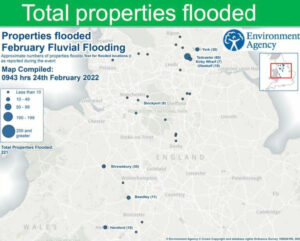Flood Risk and Economic Damages
Flooding is a problem the world over – from the recent floods in Brisbane, Australia, to the string of named storms in the UK in 2022 it is clear that flooding causes disruption to lives and livelihoods. A paper published in 2021 estimated that since the year 2000, 290 million people have been affected by flooding, with 2.3 million square kilometres of land inundated (1).
2022 has seen the UK with a record three named storms back to back in the same week (Dudley, Eunice and Franklin) causing widespread flooding from the River Severn, River Derwent and River Ouse through to Wales and the River Mersey.


The EA have estimated that some 400 properties were affected by flooding in those three storms, with some 35,000 properties protected from flooding through flood defence schemes.
Flood Damages
Flood damages, by and large are a function of depth of water against the underlying asset – in this example a property, be it residential, commercial or industrial. A property is assigned a number of costs at different depths to help obtain a relationship between depth of flood water and damage to the building. For example, a 15cm inundation to a building may cause damage to floors and furniture, and this has an economic value. A flood of 1m, will likely affect all the same items, plus electrical supplies and additional assets. This means that with depth increasing, flood cost increases as well, up to the point where a building is, in effect, a total loss and needs to be rebuilt. This ties to insurance claims, loss of earnings and structural loss.
Flood Risk Modelling for Economic Assessment
We can forecast risk to properties by using a property data base and contrasting it with flood model data to get a maximum predicted flood level at each asset location. Colour coded by risk and depth, this is the first step in creating an economic assessment.

We can repeat this process with both the defended and undefended scenarios to derive an estimate of the effect of the flood defence – what damage reduction do we get by putting in a flood defence?
Incorporating Climate Change
To get an accurate picture of the benefits over the lifetime of the asset we need to take into account climate change. The likelihood is that river flows will increase over the coming years as a result of changing climate, therefore an asset has to be built to take this into account(2).
Putting it all together
To get the final investment picture, we take the sum of damage across a range of return periods to create something called Annual Average Damage (AAD) – the likely damage that might occur in any given year – compared with the lifetime of the asset, say 25 years, if the cost of the asset is less than the sum of the damages, then the flood defence is likely economically effective. This is evaluated against the scenario called ‘do nothing’, which is what would happen if no intervention is applied. There is all sorts of additional economic analysis built into the process (accounting for inflation, uncertainty, risk and optimism bias), but that is the long and short of it.
However, the five case model(3), used by the EA takes this one step further and incorporates strategic options, long lists, short lists and monitoring and evaluation to identify a preferred option. This ensures that defences are rigorously tested and evaluated to make sure that they are fit for purpose and well considered.

Where next?
In August 2020 Public Health England published a study(4) looking at the impact of flooding on public health and wellbeing. The study concluded that there is an adverse impact of flooding on people’s wellbeing for up to 3 years after they have been flooded, indicating that the above model of economic damage may be missing a crucial aspect of economics – long-term financial impact and public health demand after a flood event. If this is the case, it has an impact on the economic business case for flood risk defences – increasing the likelihood that flood defences would meet the economic betterment criteria for approval.
As yet the economic business case model and the five case model has not been updated to include for this potential impact, but it is being considered to be amended as a result of the study.
References
(1) Tellman, B., Sullivan, J.A., Kuhn, C. et al. Satellite imaging reveals increased proportion of population exposed to floods. Nature 596, 80–86 (2021). https://doi.org/10.1038/s41586-021-03695-w
(4) https://www.gov.uk/guidance/flooding-and-health-national-study
Request your free, expert quote now
Aegaea work alongside home owners, private developers, planning consultants, architects, local authorities, international development agencies and contractors. Aegaea know exactly how to help you.